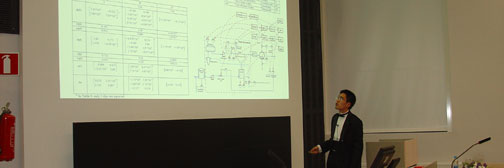| | Year 1999
Eija VapaavuoriPerformance monitoring of the Outokumpu flash smelting process through principal component analysis
The main aim of the thesis was to analyse the operation of the Outokumpu flash smelting process at smelters A and B using statistics and principal component analysis. In the literature part of the thesis the methods used for fault diagnosis are presented, the main emphasis being placed on multivariable statistical techniques such as principal component analysis and partial least squares. In addition, a short review of the industrial applications in the chemical and metallurgical industry is presented. The experimental part consists of the isolation and statistical analysis of the operational faults that occurred in the Outokumpu flash smelting process at smelters A and B. The behaviour of the process under normal and abnormal operating conditions is then studied using the principal component analysis technique.
According to the statistical analysis, excessive dust evolution and aggregation in the waste heat boiler and deterioration of the construction materials and cooling system of the boiler were the most important disturbances limiting the output of the furnace at smelter B and the second most important at smelter A. At smelter A the most important group was routine inspection and cleaning of the concentrate burner. Excessive refractory and/or cooling element wear problems in the reaction shaft and settler were the third largest group of process disturbances at smelter A.
Principal component analysis proved to be a satisfactory method for detecting the formation of material aggregations in different sections of the process. Formation of concentrate aggregations on the surface of the burner was detected on the basis of information obtained from around the reaction shaft. Concentrate aggregation was promoted by malfunctions in the feeding equipment. Other possible reasons were the chemical composition and moisture content of the feed material. Analysis of the pressure distribution in the process provided the data required in detecting the formation of flue dust aggregations in the waste heat boiler. Flue dust in the process was generated when malfunctions occurred in the feeding equipment or when the volume of the process gases was at a high level. The excessive flue dust then formed aggregations in the throat of the furnace and waste heat boiler, on the surface of the cooling banks and screens located inside the boiler and in the goose neck of the boiler and the electro
static precipitator. The high zinc content in the feed material especially promoted the formation of dust aggregations inside the boiler. Dust aggregations in the throat, boiler or goose neck prevent the normal operation of the boiler and increase the risk of material failures. There were also disturbances in the operation of the electrostatic precipitator due to excessive dust evolution.
Principal component analysis also performed well when the temperature distribution in the process was monitored. The temperature distribution in the process was analysed in order to prevent the occurrence of material failures promoted by high operation temperatures in the settler and waste heat boiler. Fluctuations in the temperature in the settler of the furnace are also an indication of deterioration of the cooling elements in the settler or the malfunctioning of the feeding equipment.
Deprecated: strlen(): Passing null to parameter #1 ($string) of type string is deprecated in C:\WWWroot\Root\incs\5_theses\theses_new2010.php on line 248
This info last modified 28 Apr 2024 - contact webmaster
|

